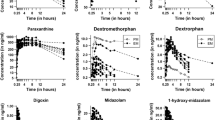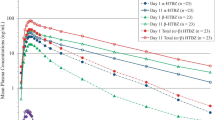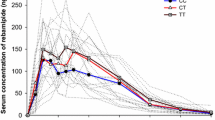Abstract
Objective: To investigate the pharmacokinetics of intravenous (IV) repinotan, a potent selective full serotonin (5-HT1a) receptor agonist, after administration of escalating doses/infusion rates to healthy volunteers with extensive or poor metaboliser phenotype, and to compare weight-adjusted (mg/kg) to fixed (mg/ day) dosing regimens.
Subjects and methods: The pharmacokinetic profile of IV repinotan was evaluated in healthy male volunteers. In eight studies, extensive metabolisers (EMs) and poor metabolisers (PMs) identified by sparteine phenotyping were given IV repinotan at doses of 5–100μg over 1 hour or 200–1000μg over 4 hours. In two additional studies of EMs and PMs, IV repinotan was administered as a weight-adjusted dose of 1 μg/kg/h for 24 hours. Repinotan plasma concentrations were measured for determination of non-compartmental pharmacokinetic parameters.
Results: Sixty-five male subjects (54 EMs and 11 PMs) were valid for pharmacokinetic evaluation. During continuous IV infusion, a steady-state repinotan plasma level was reached within 4–5 hours in EMs, and the elimination half-life was 1 hour. Pharmacokinetics were linear in EMs across a wide range of doses (5–2250μg) and infusion rates (5–250μg/h). Repinotan clearance was correlated with the log metabolic ratio (MR) of sparteine as an indicator for cytochrome P450 (CYP)2D6 phenotype, and subjects phenotyped as PMs had reduced clearance, resulting in longer elimination half-lives (up to a mean value of 11 hours) and increased peak plasma concentrations and area under the concentration-time curve values. Bodyweight was not a significant covariable for clearance and the interindividual variability in clearance was not reduced after normalisation to bodyweight. Repinotan was well tolerated at infusion rates up to 150 μg/h (EMs), and no clinically relevant safety issues were reported.
Conclusion: Repinotan demonstrates linear pharmacokinetics in EMs for CYP2D6, who constitute about 93% of the Caucasian population. Repinotan clearance is correlated with CYP2D6 phenotype and reduced in PMs. Bodyweight does not appear to be a major determinant of its pharmacokinetic variability and a bodyweight-adjusted dosing regimen is not warranted. Further studies should be performed in patients to investigate whether the tolerability profile of repinotan is comparable to that observed in healthy volunteers.







Similar content being viewed by others
References
Gladstone DJ, Black SE, Hakim AM. Toward wisdom from failure: lessons from neuroprotective stroke trials and new therapeutic directions. Stroke 2002; 33: 2123–36
Lees KR. Neuroprotection is unlikely to be effective in humans using current trial designs: an opposing view. Stroke 2002; 33: 308–9
Stroke Therapy Academic Industry Roundtable II (STAIR II). Recommendations for clinical trial evaluation of acute stroke therapies. Stroke 2001; 32: 1598–606
De Vry J, Dietrich H, Glaser T, et al. BAY x-3702. Drugs of the Future 1997; 22: 341–9
Horvath E, Augstein K-H, Wittka R. Neuroprotective effect of the novel 5-HT1a receptor agonist BAY x 3702 in a rat model of permanent focal cerebral ischemia and traumatic brain injury [abstract]. Soc Neurosci 1997; 23: 1923
Teal P, BRAINS, a phase II study of the neuroprotectant, BAY x 3702 in patients with ischemic stroke [abstract]. Cerebrovasc Dis 1998; 8 Suppl. 4: 20
Fleckenstein L, Roche L, Sundaresan PR, et al. Ascending-dose safety and tolerability study of BAY x 3702 in healthy elderly males and females [abstract]. Clin Pharmacol Ther 1998; 63: 190
Eichelbaum M, Gross AS. The genetic polymorphism of debrisoquine/sparteine metabolism: clinical aspects. Pharmacol Ther 1990; 46: 377–94
Bertilsson L, Dahl ML. Polymorphic drug oxidation, relevance to the treatment of psychiatric disorders. CNS Drugs 1996; 5: 200–23
Acknowledgements
This work was funded by Bayer HealthCare AG, Wuppertal, Germany.
Author information
Authors and Affiliations
Corresponding author
Rights and permissions
About this article
Cite this article
Heinig, R., Böttcher, M.F. Pharmacokinetics of Escalating Doses of Intravenous Repinotan in Healthy Male Volunteers. Clin. Drug Investig. 25, 115–123 (2005). https://doi.org/10.2165/00044011-200525020-00004
Published:
Issue Date:
DOI: https://doi.org/10.2165/00044011-200525020-00004




